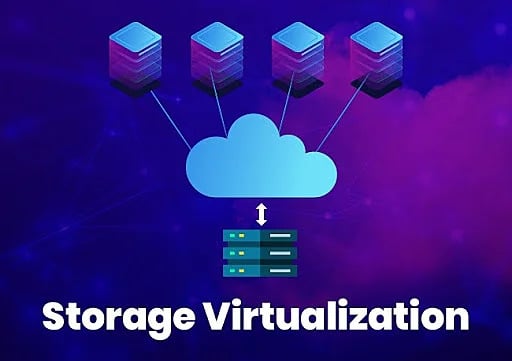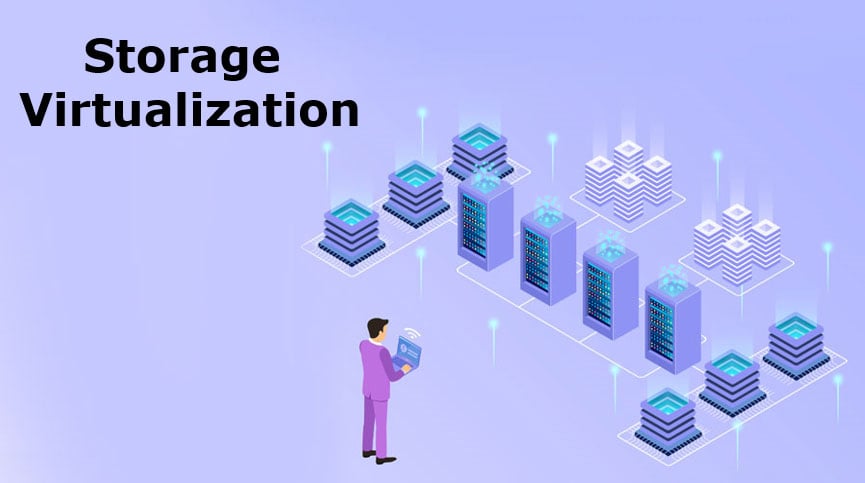Storage Virtualization: What you need to know?
Virtualization is a very big term in the Information Technology (IT) world and almost everything in this IT world has been virtualized. Whether it is a server, Storage Area Network (SAN), memory, network, or storage, all things can be virtualized. In this article, we will tell you about “Storage virtualization”. Every system administrator or beginner should know about storage virtualization, so do read the full article.
What is Storage Virtualization?
Storage virtualization (also sometimes called software-defined storage or a virtual SAN) is the pooling of multiple physical storage arrays from SANs and making them appear as a single virtual storage device. The pool can integrate unlike storage hardware from different networks, vendors, or data centers into one logical view and manage them from a single pane of glass.
Virtualizing storage separates the storage management software from the underlying hardware infrastructure to provide more flexibility and scalable pools of storage resources. And not only that, but it can abstract storage hardware (arrays and disks) into virtual storage pools, in the same way, compute virtualization (VMWare ESX or Hyper-V) abstracts compute hardware (servers) into virtual machine instances (VMs).

How does it work?
To provide access to the data stored on the physical storage devices, the virtualization software needs to either create a map using metadata or, in some cases, use an algorithm to locate the data on the fly dynamically. The virtualization software then intercepts read and write requests from applications and using the map it has created it can find or save the data to the appropriate physical device. This process is similar to the method used by PC operating systems when retrieving or saving application data.
Storage virtualization disguises the actual complexity of a storage system, such as a SAN, which helps a storage administrator perform the tasks of backup, archiving, and recovery more easily and in less time.
What are the benefits of Storage Virtualization?
- Lower cost: Because virtual storage doesn’t require the typical hardware redundancies needed in traditional enterprise storage architectures for disaster recovery, fewer appliances and/or software licenses need to be purchased. This saves enterprises from the significant cost of up-front financial commitments.
- Saved time: Virtualized storage not only reduces downtime – planned and unplanned – but it also makes upgrading much less time-consuming and disruptive.
- Scalability: With virtual storage, organizations no longer need to forecast their long-term future storage needs or pay for all that capacity upfront. Instead, IT can take advantage of dynamic provisioning that responds to changing needs on demand.
- Easier management: Virtual storage simplifies and improves resource use, providing an easy addition/deletion of storage without interrupting applications. It also enables seamless data migration and streamlines advanced feature applications across the storage pool.
- Reduced risk: If a disk drive, storage controller, or power supply were to fail, each is already mirrored in the virtual array, so the risk of disruption is considerably reduced. That virtual redundancy limits slower performance and increases storage efficiency and flexibility.
- Increased productivity: Virtual storage not only delivers 100% availability, but it also has the potential to accelerate app and service deployments to realize value faster.
- Improved efficiency: Getting faster storage with better capacity utilization is the biggest benefit. It also provides more stability to data access and processing. In addition, virtual storage ensures 100% utilization and has little chance of running out of capacity.

Types of Storage Virtualization
At the data level, there are two types of storage virtualization: Block-based and File-based.
- Block-based: Block-based storage virtualization is the most common type of storage virtualization being practiced across organizations. It identifies all available blocks on individual media/paths irrespective of location or vendor, and then the engine leaves that data in the physical position and maps the address to a virtual storage device.
- File-based: File-level virtualization works over NAS devices. It has a challenge of its own because managing different NAS devices can be tedious work. Managing multiple appliances is time-consuming and costly. NAS devices require individual management, and users need to know the physical pathname to access a file. Migration of data from old to new NAS devices also remains a challenge as it results in downtime, leading to additional costs to the company.
Storage Virtualization Use Cases
Virtualization increases storage efficiency. Here are some best use cases for storage virtualization:
Virtualization for Public Cloud Storage
Managing a hybrid cloud environment simultaneously is extremely difficult. However, virtualization allows you to replicate heterogeneous storage systems between cloud infrastructure and on-premise. This allows for consistent data management, backup, and heightened data backup. The replication of on-premise data enables streamlined cloud DevOps.
Virtualization for SAN Storage
Enterprise-class SAN virtualization allows you to enjoy advanced functionalities, tiered storage, and simplified storage infrastructure management. Virtual SAN helps organizations achieve better efficiency as it supports large-scale workloads.
Virtualization for Flash Storage
Virtualizing for flash storage allows you to balance performance with data storage features with the organization’s workload needs. A flash system provides cost-efficient virtualized storage for organizations of all sizes and enterprise-class data services.

What is Storage Virtualization in Cloud Computing?
Storage virtualization in Cloud Computing is nothing but the sharing of physical storage into multiple storage devices which further appears to be a single storage device. It can be also called a group of available storage devices which simply managed from a central console.
This virtualization provides numerous benefits such as easy backup, achieving, and recovery of the data.
This whole process requires very little time and works efficiently. Storage virtualization in Cloud Computing does not show the actual complexity of the SAN. This virtualization applies to all levels of SAN.
Conclusion
The right storage solution offers value for money, security, excellent vendor support, cost-cutting, and high performance. Also, selection should depend on what storage technology you are using, whether it is SSD, Hard disk, Cloud, or storage arrays. The sheer volume of data also remains the number one concern today. Storage virtualization helps manage vast amounts of data that need to be moved or curated on a timely basis.